I recently found the below video, showing a number of different dances in which the trombone serves as a member of what is commonly called the alta capella.
Below the video I have added a selection of entries and pictures from the Trombone History Timeline that highlight the trombone’s role in dance music, a major aspect of membership in the alta capella (Renaissance wind band typically formed around members of the shawm family). Lasting well over a century, the trombone’s dance role appears to peak in the 16th century and is perhaps somewhat under-represented in literature on the history of the trombone.
1459—Florence, Italy: At a dance hosted by Cosimo de’ Medici, an observer reports, “In this time shawms and trombones began to play a saltarello based on art and reason. Then every courteous and nimble squire took wives and damsels and began to dance this or that; some promenading around, others skipping, others changing hands, some stopping and some inviting, some in twos or in threes doing lovely dancing” (Sparti 135; Gombosi, About Dance).
1460s—Augsburg, Germany: The city is temporarily without a trombonist for their civic wind band, but continues to hire a trombonist “for especially important dances” (Polk, German 118).
1518—The betrothal of Princess Mary, daughter of Henry VIII, to François, eldest son of François I, King of France, takes place in Greenwich, with a repeat performance in Paris. Festivities include a dance performed by a wind band that probably consists of 3 shawms and 2 trombones (“two brass which were bent back”) (Shaw).
1520—France: King Henry VIII of England meets with King Francis I of France at the Field of the Cloth of Gold. An one point in related celebrations at nearby Guines (France), King Francis leads a dance accompanied by his own fifes and trombones (Russell 164).
c. 1545—Nuremberg, Germany: An anonymous depiction of a dance, Fastnachtstanz von Metzgern im Jahre 1519 (Carnival Dance of the Butchers in the Year 1519), portrays a trombone as a member of a wind instrument trio providing music for a Nuremberg carnival dance (see upper-right of below image; click on image for larger version; public domain) (Salmen, Musikleben im 16 78-79).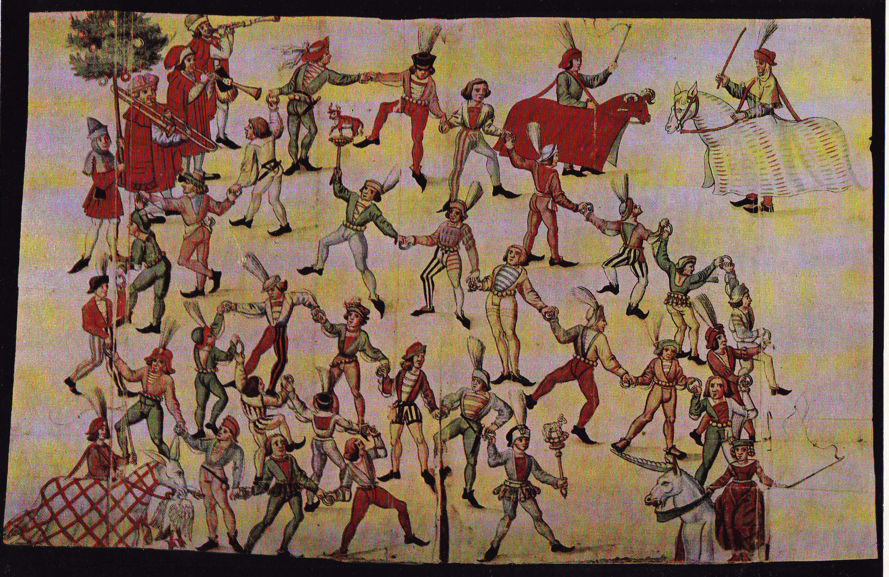
c. 1550—Nuremberg, Germany: Patriziertanz im Grossen Nürnberger Rathaussaal, an anonymous image depicting a dance in Nuremberg’s town hall, includes 2 trombonists among the 5 wind musicians providing the dance music from the balcony. One of the unusual aspects of the image is that both trombonists have banners hanging from their slides (see upper-left of below image; click on image for larger version; public domain) (Nuremberg, Stadtavchiv; Salmen, Tanz im 17 148).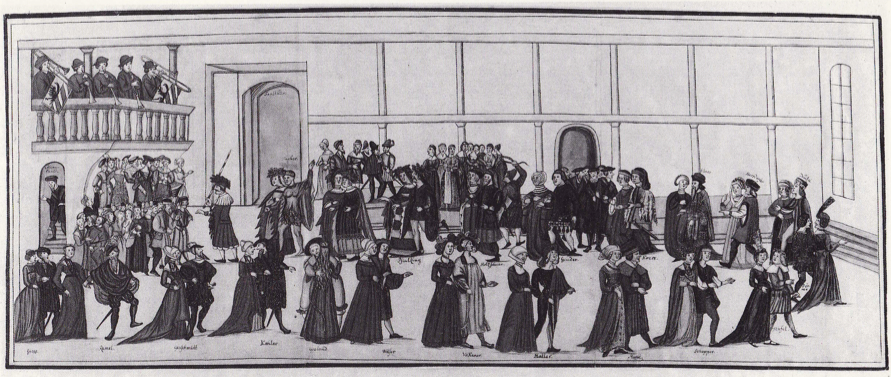
1588—France: Thoinot Arbeau mentions the trombone in Orchesography, his treatise on dancing. First, he complains, “Nowadays there is no workman so humble that he does not wish to have hautboys and sackbuts at his wedding” (Arbeau 51). Later, he describes use of the instrument by royalty for dances on solemn feast days: “On solemn feast days the pavan is employed by kings, princes and great noblemen to display themselves in their fine mantles and ceremonial robes. They are accompanied by queens, princesses and great ladies, the long trains of their dresses loosened and sweeping behind them, sometimes borne by damsels. And it is the said pavans, played by hautboys and sackbuts, that announce the grand ball and are arranged to last until the dancers have circled the hall two or three times, unless they prefer to dance it by advancing and retreating. Pavans are also used in masquerades to herald the entrance of the gods and goddesses in their triumphal chariots or emperors and kings in full majesty” (Arbeau 59).
c. 1600—Augsburg, Germany: An oil painting by Abraham Schelhas titled Augsburger Geschlechtertanz depicts an aristocratic dance in Augsburg. The 4 wind musicians providing the music play from a balcony and include a trombonist; the other instruments appear to be shawms (see below detail and full image below that; public domain) (Augsburg, Städtische Kunstsammlung; Salmen, Tanz im 17 151).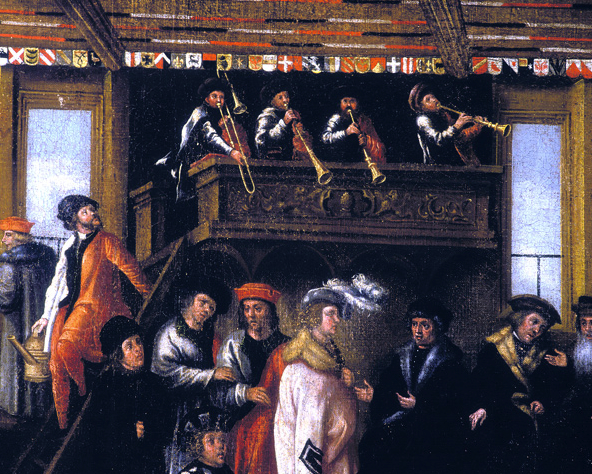
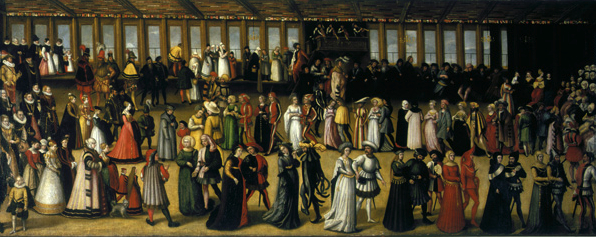
c. 1600—Fackeltanz bei Fürstenhochzeit, an anonymous image, possibly from Germany, depicts a torch dance at a prince’s wedding. Instrumentalists supplying the dance music from a balcony include a tombonist (see upper portion of below image; public domain) (Salmen, Tanz im 17 153).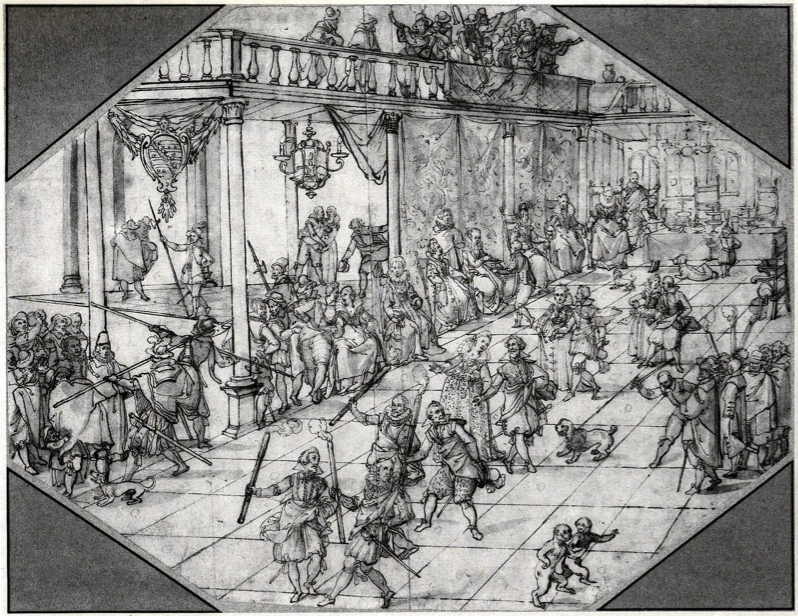
1609—Prince Francesco, setting up his court as governor of the Mantuan province of Monferrato, seeks assistance of Ercole Gonzaga in hiring group of pifferi from Cremona (Kurtzman, Trombe). Claudio Monteverdi is also engaged in assisting Prince Francesco, and refers to the players he is recruiting in a letter to the court secretary. In his description of their abilities he mentions, “They play together well and readily both dance and chamber music, since they practise every day” (Stevens Letters 64).
1700s—The Netherlands: An anonymous eighteenth-century Dutch etching features trombone and cornetto, seemingly dancing as they perform. The text reads, “I have to bend down, holding my instrument of pipes, so as to direct it so it will give a sound. Look how my club hangs from my body, as a result of my movements. Hear my bells ring. I blow the zink and make it sound distinguished. With it I can easily cure the sick. Though I can lower and raise the sound, my lungs remain full of air, and my pochet remains empty” (see below image; public domain) (Naylor 63).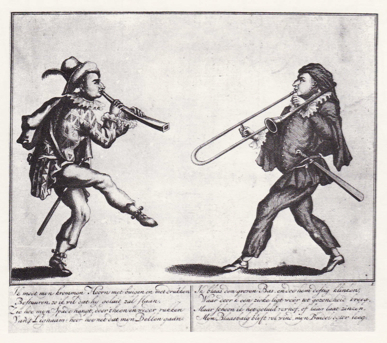
Continue to Trombone and the Dance, part II